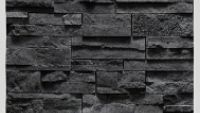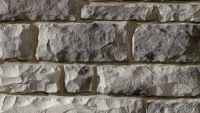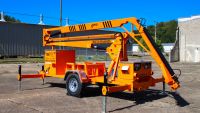St. Louis Market Adds New Product To Masonry Portfolio
Plan on putting 1,100 teenagers in a building, and it won't take long for noise control to make its way onto the priority "must have" list.
So when planners of the West Middle School in O'Fallon, MO, just outside of St. Louis, set out to build the 119,000- square-foot school from structural block, they wanted to incorporate sound control into the design. They found their answer in a relatively new product: Sound Cell, a structural block that comes in 8 and 12 inch widths with sound absorbing qualities. Plans to include sound control upfront pleased Project Architect Rich Bacino, of Cannon Design.
Because of cost, to add sound control, school districts often come back later," Bacino said, adding with the Sound Cell, " You didn't have to buy anything above and beyond."
"It was cost-effective," said Jeff Leonard, president of Leonard Masonry Inc., the contractor for the project. "We were worried about it being expensive, but is was just a slight premium to go with this unit," Leonard said.
Folding the acoustical option into the wall not only was efficient, it allowed for more design opportunities. Light falling on the angled face of a Sound Cell through skylights and windows allows for shadows to form and play off the textures and patterns of the block ? something traditional sound blocks don't offer, Bacino said. Traditional sound blocks with open slots to absorb sound have been around for about 30 years but don't offer the same design opportunities because of the flat surface of the block. They also can't be spray painted because it clogs the sound absorption insert. The Sound Cell, on the market for three years, can be spray painted and solves an aesthetics need as well as a functional one, he said.
And while Bacino and his firm are the first to use the product in the St. Louis area, it has caught on with architects who have used it for 48 projects in a variety of states, said Kerry VonDross, CCCM, sales manager for Best Block Co., the Milwaukee company that manufactures the product. More than 100,000 units have sold, VonDross said. Architects like it so much they're willing to pay the trucking fees in states that don't yet have distributors, he said. To facilitate availability, Best Block is expanding its distribution and manufacturing.
The block is easy to work with, according to Leonard. "We were worried about what kind of productivity we could get and quality," he said, adding, "It turned out better than we expected. It turns out the productivity isn't any less, it might be a little bit better. I feel like this is a better look for no more cost."
The product is economic, divisional, load bearing, energy-efficient and aesthetically pleasing, said Wally McNeill, CSI,CDT, Masonry Division Manager for Kirchner Block & Brick Inc. Mixed with standard block in the gymnasium and cafeteria/commons areas of the school, 3,650 of the 12-inch width blocks were ordered, McNeill said. The units were placed high on three of the gymnasium walls, with the fourth wall using only structural blocks so a mascot could be painted on the wall. On the cafeteria/commons wall, the Sound Cells were placed at a height that was calculated to be out of the reach of middle school students because of the openings in the block. While the units absorb sound, they won't dissipate tuna sandwiches.
But perhaps the best feature of the blocks is that when the West Middle School Wild Cats come charging down home court, fans will only hear the action once instead of constant reverberations coming off the walls. That ringing noise, the high end of the frequency range, that fills a gymnasium by the end of a game is known in acoustical terms as flutter echo, according to VonDross. Noise travels, hits a wall and bounces back mixing with the latest cheering and a cycle begins. The noise keeps building into a big ringing crescendo that doesn't end until the crowd clears out.
Without carpeting, drapes or upholstered furniture in the gym and cafeteria to absorb the noise, the Sound Cells work by collecting the sound and diffusing it similar to ocean water coming in and hitting break waters. The recessed opening of the block draws the sound into the fiberglass/foam inserts; entering sound waves cause friction and a small amount of heat, which dissipates the sound. "Trapezoidal walls would also reduce flutter echo, but that's expensive," VonDross said. The Sound Cell has 77 percent of its surface skewed to combat the problem.
The concept isn't new, only improved. In ancient times, Greeks and Romans used large pots in open air theaters to improve resonance. In Sweden and Denmark, pots were embedded in the walls of medieval churches. Ashes were used as dissipative agents. For sound absorption, the Sound Cell uses a Helmholtz volume resonator tuned to the frequency of sound. The idea is the same as if you blow across the top of an empty Coke bottle. You'll get a tone. If you add water and do it again, the tone will change to a higher pitch. Unlike the Coke bottle, the Sound Cell has a rougher interior and an insert that is especially good at capturing low frequency sound, such as tubas and drums.
Without sound treatment, "those things will just start flying around causing noise and not music," he said. "Most of the other sound blocks on the marketplace are limited to smaller cavities (used to capture sound)," VonDross said. With the larger cavity, there is better sound absorption at the lower end of the sound frequency, 100-200 Hz, absorbing 100 percent of the sound, he said.
Since the Sound Cells are structural block, incorporating them with the overall design of the building made for a cohesive blend. Four different patterns of concrete block were used on the exterior in gray, white, parchment and ivory. Various sizes of block and bands of color formed positive and recessed patterns that mirrored each other on the exterior and interior of the building.
Assistant Superintendent for facilities and construction Bill Weber said the district was pleased with the design, and that the building turned out as he pictured it. "What I like about the exterior is it's nontraditional, said Mark Wilhelms, sales manager for Kirchner Block & Brick Inc. "This cannot be duplicated by tilt-up," Wilhelms added. Leonard agreed. "This is the kind of thing they (precast contractors) can't do." "I want architects thinking masonry can be fun," Wilhelms said.
"From a contractor's view, the Sound Cell is one more tool in the masonry portfolio that helps with competition," Leonard said. "Leonard Masonry, like other masonry contractors, strives to stay cost-effective and compete with other systems, such as precast. Unlike plumbers or electricians who have job opportunities with every new building, there are many materials that can take the place of masonry," he said.
Leonard commended the St. Louis distributor. "We appreciate companies like Kirchner because they're willing to bring new products to the market place, and we recognize it costs them money to do that. Usually we're the ones on the battle lines, fighting the war," he said.
About the Author


















